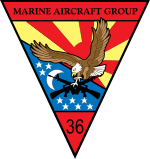- Marine Aircraft Group 36
-
Marine Aircraft Group 36 
MAG-36 insigniaActive 2 June 1952 – present Country United States Branch USMC Role Assault support Part of 1st Marine Aircraft Wing
III Marine Expeditionary ForceGarrison/HQ Marine Corps Air Station Futenma Commanders Current
commanderCol Jeffery K. Arruda Notable
commandersEarl E. Anderson Marine Aircraft Group 36 (MAG-36) is an active air group of the United States Marine Corps, tasked with providing assault support aircraft. It is currently part of the 1st Marine Aircraft Wing (1st MAW), itself an integral part of the III Marine Expeditionary Force, and based at Marine Corps Air Station Futenma in Okinawa, Japan.
Contents
Mission
The mission of MAG-36 is to support the Marine Air Ground Task Force (MAGTF) with combat ready expeditionary assault support aircraft and when directed, plan and conduct aviation operations as a Marine Expeditionary Brigade-level Aviation Combat Element.[1]
Subordinate units
- HMM-262
- HMM-265
- VMGR-152
- MALS-36
- Also attached are Unit Deployment Program (UDP) squadrons, usually Marine Light Attack Helicopter Squadrons flying the UH-1N and AH-1W, and Marine Heavy Helicopter Squadrons flying the CH-53E.
History
Originally formed at Marine Corps Air Station El Toro, in Santa Ana, California, on 2 June 1952 as Marine Air Group (Helicopter Transport) 36, the Group spent several years training for amphibious operations to carry out the role of ship-to-shore assault support. At this time, the Group consisted of squadrons HMR-361, HMR-362, HMR-363, all flying HRS-1 helicopters.
In 1959, it was renamed Marine Air Group 36, and in 1965 attached to the 1st MAW, when it deployed to Vietnam in August of that year. It sailed for Vietnam aboard the USS Princeton, flying ashore at Chu Lai on 1 September. This was both the first full Marine Air Group to arrive in Vietnam, and more generally the first time a full helicopter group had been transported this way.
The Group participated in a wide variety of support missions during the Vietnam War, ranging from assault missions to medical evacuation and logistical flights using UH-1 E gunships, CH-46 Sea Knights, and UH-34 Seahorses. In 1968, it was closely involved in support of actions in Huế during the Tet Offensive.
On 4 November 1969, MAG-36 withdrew from Vietnam and re-based to MCAS Futenma, Okinawa, Japan. VMGR-152, which had provided combat air refueling for detachments in Vietnam from Futenma since 1965, became a part of MAG-36 at that time. Until 1972, MAG-36 provided support squadrons to Marine Amphibious Unit aboard ship. In 1972, VMGR-152 was deployed to Thailand and Vietnam to provide refueling services to 1st MAW aircraft, whilst attack squadrons carried out operations against North Vietnamese logistics as part of the 7th Fleet. In early 1973, MAG-36 squadrons participated in clearing Haiphong harbor of mines, after which they returned to Futenma.
On 11 April 1975, the group provided transport for Operation Eagle Pull – the successful emergency evacuation of Americans from Cambodia. Following this, the Group deployed all of its available aircraft aboard 7th Fleet ships and in the famous Operation Frequent Wind, on 29 April 1975 in a 24-hour period, evacuated over 7000 people from Saigon aboard MAG-36 helicopters.
From the late 1970s through the 1980s, MAG-36 continued to support fleet operations in the Pacific Theater. MAG-36 became the Unit Deployment Program (UDP) linchpin in the Western Pacific (WestPac). As part of the UDP, CH-46, CH-53, and OV-10 squadrons from Hawaii and California deployed to MCAS Futenma for six-month rotations. During these deployments MAG-36 participated in numerous exercises and training deployments to various countries around the WestPac.
In November 1992, the last UDP detachment of OV-10s returned to Camp Pendleton, CA. In the spring of 1993, HMM-262 arrived from Hawaii to become a permanent part of MAG-36. HMM-262 was followed by HMM-265, and these two CH-46 squadrons have formed the backbone of the 31st MEU Aviation Combat Element.
Throughout the 1990s, MAG-36 units participated in a variety of contingency operations. In 1995, MAG-36 units conducted relief operations in Kobe Japan after 6,400 people lost their lives in a massive earthquake and also participated in the withdrawal of United Nation Forces from Somalia during Operation UNITED SHIELD. In 1999, units responded to a no-notice deployment to the Persian Gulf for Operation DESERT FOX and to East Timor for peacekeeping during Operation STABILIZE.
During the first decade of the 21st century, MAG-36 units continued to support Theater Security Cooperation exercises and numerous contingency operations. In 2004 and 2007 respectively, HMM-265 and HMM-262 deployed for Operation IRAQI FREEDOM combat operations. Since May of 2009, VMGR-152 has been providing an enduring two-plane detachment to Afghanistan for Operation ENDURING FREEDOM.
Nearly every year, MAG-36 deploys as a MEB-level Aviation Combat Element, often supporting Humanitarian Assistance and Disaster Relief (HADR) operations. In November of 2007, in the wake of Tropical Cyclone Sidr MAG-36 elements deployed to Bangladesh for Operation SEA ANGEL II. MAG-36 supported Operation CARING RESPONSE in May 2008 from Thailand after Tropical Cyclone Nargis impacted Burma. Additionally, MAG-36 has conducted HADR in the Philippines on three separate occasions: during 2004 with Joint Task Force 535, following three back-to-back typhoons in October 2009, and again in October 2010 in the wake of Super Typhoon MEGI. Most recently during Operation TOMODACHI, MAG-36 deployed to mainland Japan immediately following the triple-disaster created by an earthquake, tsunami, and damaged nuclear reactor to provide much needed relief to our host nation.[2]
See also
- United States Marine Corps Aviation
- List of United States Marine Corps aircraft groups
- List of United States Marine Corps aircraft squadrons
References
- Notes
 This article incorporates public domain material from websites or documents of the United States Marine Corps.
This article incorporates public domain material from websites or documents of the United States Marine Corps.
- Bibliography
- Web
MAG-12 
MAG-24 MAG-36 MACG-18 MWSG-17 Categories:- United States Marine Corps aircraft groups
Wikimedia Foundation. 2010.

